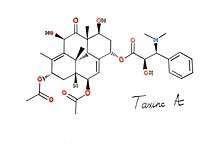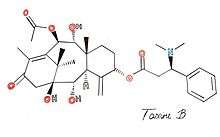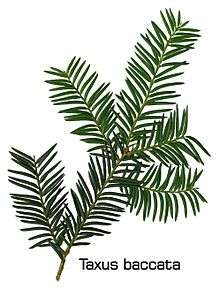Taxine


Taxine is a toxic alkaloid compound present in the Yew tree, Taxus baccata.[1] It is composed of more than seven alkaloids, the main constituents being taxine A and taxine B;[2] the other components are their derivatives, such as 2-deacetyltaxine A, isotaxine B and 1-deoxytaxine B.[3]
This substance is characterized by high melting and boiling point. Taxine is soluble in chloroform and alcohol, and insoluble in water or oil. [4]
| Properties of Taxine A | |
|---|---|
| Molecular Formula | C35H47NO10 |
| Molecular weight | 641.758 g/mol |
| Molar volume | 499.9 ± 5.0 cm3 |
| Density | 1.3 ± 0.1 g/cm33 |
| Boiling Point | 747.1 ± 60.0 °C at 1 atm |
| Enthalpy of Vaporization | 114.3 ± 3.0 kJ/mol |
| Index of Refraction | 1.587 |
| Rotatable Bond Count | 10 |
| Properties of Taxine B | |
|---|---|
| Molecular Formula | C33H45NO8 |
| Molecular weight | 583.7123 g/mol |
| Molar volume | 466.4 ± 5.0 cm3 |
| Density | 1.3 ± 0.1 g/cm3 |
| Boiling Point | 676.9 ± 55.0 °C at 1 atm |
| Enthalpy of Vaporization | 104.4 ± 3.0 kJ/mol |
| Index of Refraction | 1.588 |
| Rotatable Bond Count | 8 |
Provenance

Taxine can be found in Taxus species: Taxus cuspidata, T. baccata (English yew), Taxus x media, Taxus canadensis, Taxus floridana and Taxus brevifolia (Pacific or western yew). All of these species contain taxine in every part of the plant except in the aril, the fleshy covering of the seeds (berries). Each species contains a different amount of taxine concentration, which leads to varying toxicities within the genus. This is the case of the Taxus brevifolia or Pacific yew and the Taxus baccata (English yew); T. brevifolia contains high taxine concentration, which leads to a high toxicity, whereas T. baccata has a low toxicity. There are seasonal changes in the concentrations of taxine in yew plants, with the lowest concentrations during the winter.[5] Taxus species are one of the few trees that when they die, the poison is not destroyed, in other words, the effect of the Taxine continues functioning independently of the life of the yew in which it is contained.[6]
These species have distinctive leaves, which are needle like, small, spirally arranged but twisted so they are two-ranked, linear-lanceolate. They are also characterized by their ability to regenerate from stumps and roots.[7] They are found all over Europe and live in conditions similar to the oceanic specia and better in mixed forests (coniferous), on limestone substrates, and occupy rock cliffs and slopes. They are sensitive to low temperatures, the reason why they cannot be found in Northern Scandinavia. [8]
Toxicity in humans


The taxine poisoning occurs when someone eats parts of the yew tree.Taxine is found in all parts of the tree, except in the aril, that is the covering of the seeds and the yew's fruit. Despite that, the most toxic part of the yew tree is the seeds because they have a huge quantity of taxine inside.
Taxine remains in the plant all the year, with maximal concentrations appearing during the winter. Dried yew plant material retains its toxicity for several months, this is why fallen leaves are so toxic and often eaten by animals or persons. The lethal dose of leaves is quite small: just 50g-100g of leaves are enough to kill a human because taxine is a very powerful cardiotoxin.[9]
Although it is said the poisoning occurs after someone eats any part of the yew tree, there have been also cases in which the person has breathed shavings and dust from the yew tree, which still contain taxine. When accidentally it was inhaled, this material had ended in the digestive tube which originated the symptoms of poisoning.[10]
Clinical signs
Sometimes, the first evidence of yew poisoning is an unexpected death, because taxine is rapidly absorbed for the body, so in some cases the death is so premature that any symptom is manifested.
In other cases patients presents symptoms and the death occurs several hours or days after the ingestion. The common effects are:
- Nausea and vomiting
- Diarrhea
- Abdominal pain
- Headache
- Dizziness and tremor
- Blue lips
- Collapse
- Heartbeat problems: irregular heartbeat , bradycardia, arrhythmia and hypotension[11]
- Circulatory collapse
- Coma
- Convulsions
- Respiratory distress and respiratory failure[12]

Diagnosis
The diagnosis of the yew poisoning is really important if the patient does not know he had ingested parts of the yew tree. The method used for the diagnosis is the determination of 3,5-dimethoxyphenol, a product that comes from the break of taxine's glycosidic bond, in the blood, the gastric content, the urine and the tissues of the patient. This determination of taxine can be done by gas or liquid chromatography and also by mass spectroscopy.
Treatment
Nowadays there are no specific antidotes for taxine, so patients can only receive treatment for their symptoms.
The first thing that should be done is a rapid stomach dump by a gastric lavage, followed by the administration of cathartics and activated carbon. Inducing vomiting is another option to purge the stomach but if large amounts of taxine have been absorbed this has the risk of triggering nervous and cardiac system complications. After the gastric lavage it is necessary to examine the gastric contents for yew leaves and submit samples for taxine determination.
It is also quite important to control the blood pressure and the heart rate to treat the heart rate problems. The atropine has been used successfully in humans to treat barycardias and arrithymias caused by taxine. It is more effective if it is administrated early, but it is also necessary to be cautious with the administration because it can produce an increase in myocardial oxygen demand and potentiate myocardial hypoxia and dysfunction. An artificial cardiac pacemaker can also be installed to control the heartbeat.
Other treatments are useful to treat the other symptoms of poisoning: positive pressure ventilation if respiratory distress is present; fluid therapy to support blood pressure and maintain hydration and renal function; gastrointestinal protectants; and it could also be necessary to control aggressive behaviour and convulsions with tranquilizers.[13]
Prevention
The toxic effects of T. baccata had been known since ancient times, in most of the cases, the intoxification is accidental, specially in cases where children or animals are involved. However, there are other cases in which the intoxification is used as a suicide method.[14]
Because taxine poisoning is often diagnosed after the death of the patient due to its rapidly effect, preventing exposure is very important. Dried parts of the plant are also toxic because they contain taxine's molecules, so it is necessary to be sure that any person, child or animal has not access to any parts of the plant. Pet owners had to be sure that yew branches or leaves are not used as toys for dogs or as perches for domestic birds.
Toxicity in animals
The effects of Taxine in humans are very similar to the effects on animals. It has the same mechanisms of action, and most of the times the ingestion of yew material is diagnosed with the death of the animal. Moreover, clinical signs, diagnosis, treatment and prevention are mostly the same as in humans. This was seen due to the many experiments realized on rats, pigs… [15]
However, there are some animals that are immune to the effects of taxine such macaws and white-tail deer. This is due to the fact that they have developed mechanisms to avoid the absorption of Taxine into their system and be capable of feeding of Taxus’ leaves. The reason why these animals are capable of eating yew material is thanks to evolution. In order to keep their species, a mutation took place in an individual and this meant an advantage and an improvement to the species. Therefore, the ones who lived in areas where Taxus species were present, they could feed better and survive unlike the other ones. So the mutation resulted into something beneficial and has given to these animals immune mechanisms to avoid the absorption of Taxine into their systems.[16]
Mechanism of action
The toxicity of the yew plant is due to some substances that are found in it, the principal ones are: toxic alkaloyds (taxine B, paclitaxel, isotaxine B, taxine A), glycosides (taxicatine) and taxane derivates (taxol A, taxol B).[17]
There have been a lot of studies about the toxicity of the taxine alkaloyds[18][19] and they have shown that their mechanism of action is interfering with the sodium and calcium channels of the myocardial cells, increasing the cytoplasmic calcium concentrations. Their mechanism is similar to drugs such as verapamil, although taxines are more cardioselective.[20] They also reduce the rate of the depolarization of the action potential in a dose-dependent manner. This produces bradycardia, hypotension, depressed myocardial contractility, conduction delay, arrhythmias… [21]
Some taxine alkaloyds have been isolated to study its effects and characteristics, this has allowed to know some of the particular effects of each substance of the plant, for example: it showed that taxine A doesn’t influence in blood pressure, that taxol causes itself cardiac disturbances in some patients, and that taxine B is the most toxic substance.[22]
There has been a recent discovery in a molecule derived from the yew: placlitaxel. It has been proved that it functions as an anticancerdrug, because of it there have been some investigations to show if taxine B could be also used as a pharmacodrug, but it hasn’t been proved yet.[23]
See also
References
- ↑ "Taxine". Toxnet. NLM. 2009-01-05.
- ↑ Cazes, Jack (2005). Encyclopedia of Chromatography, Vol.2. Taylor & Francis Group. p. 1660.
- ↑ Wilson, C. R.; Sauer, J.; Hooser, S. B. (2001). "Taxines: A Review of the Mechanism and Toxicity of Yew (Taxus spp.) Alkaloids". Toxicon. 39 (2–3): 175–85. doi:10.1016/s0041-0101(00)00146-x. PMID 10978734.
- ↑ http://www.guidechem.com/reference/dic-409796.html
- ↑ http://aspcapro.org/sites/pro/files/zk_vetm0905_646_650.pdf
- ↑ http://www.thepoisongarden.co.uk/atoz/taxus_baccata.htm
- ↑ http://aspcapro.org/sites/pro/files/zk_vetm0905_646_650.pdf
- ↑ http://www.iucnredlist.org/details/42546/0
- ↑ "Intoxicación por tejo".
- ↑ José Luis Hernández Hernández; Fernando Quijano Terán; Jesús González Macías (2010). "Intoxicación por tejo". Medicina Clínica.
- ↑ "Toxnet: Taxine".
- ↑ "MedlinePlus: Yew poisoning".
- ↑ R.B. Cope (September 2005). "The dangers of yew ingestion" (PDF). Veterinary Medicine.
- ↑ "Suicidal poisoning by ingestion of Taxus Baccata leaves. Case report and literature review" (PDF). Romanian Journal of Legal Medicine. XXI (2(2013)).
- ↑ http://aspcapro.org/sites/pro/files/zk_vetm0905_646_650.pdf
- ↑ http://poisonousplants.ansci.cornell.edu/yew.html
- ↑ Ramachandran, Dr. Sundaram (2014). Heart and Toxins. p. 160. ISBN 9780124165953.
- ↑ "Taxine- Mechanism of action". PubChem.
- ↑ Tekol Y. "Negative chronotropic and atrioventricular blocking effects of taxine on isolated frog heart and its acute toxicity in mice". PubMed.
- ↑ Tekol Y; Göğüsten B. "Comparative determination of the cardioselectivity of taxine and verapamil in the isolated aorta, atrium and jejunum preparations of rabbits.". PubMed.
- ↑ G. Barceloux, Donald (2008). Medical Toxicology of Natural Substances: Foods, Fungi, Medicinal Herbs, Plants, and Venomous Animals. p. 900. ISBN 9780471727613.
- ↑ Suffness, Matthew (1995). Taxol: Science and Applications. p. 311.
- ↑ Barbara Andersen, Karina (2009). "Future perspectives of the role of Taxines derived from the Yew (Taxus baccata) in research and therapy". Journal of Pre-Clinical and Clinical Research. 3 (1).
Further reading
Asheesh K. Tiwary, Birgit Puschner, Hailu Kinde, Elizabeth R. Tor (2005). "Diagnosis of Taxus (Yew) poisoning in a horse". Journal of Veterinary Diagnostic Investigation.
Andrea Persico, Giuseppe Bacis, Francesca Uberti , Claudia Panzeri, Chiara Di Lorenzo, Enzo Moro, and Patrizia Restani (2011). "Identification of Taxine Derivatives in Biological Fluids from a Patient after Attempted Suicide by Ingestion of Yew (Taxus baccata) Leaves". Journal of Analytical Toxicology. Vol. 35